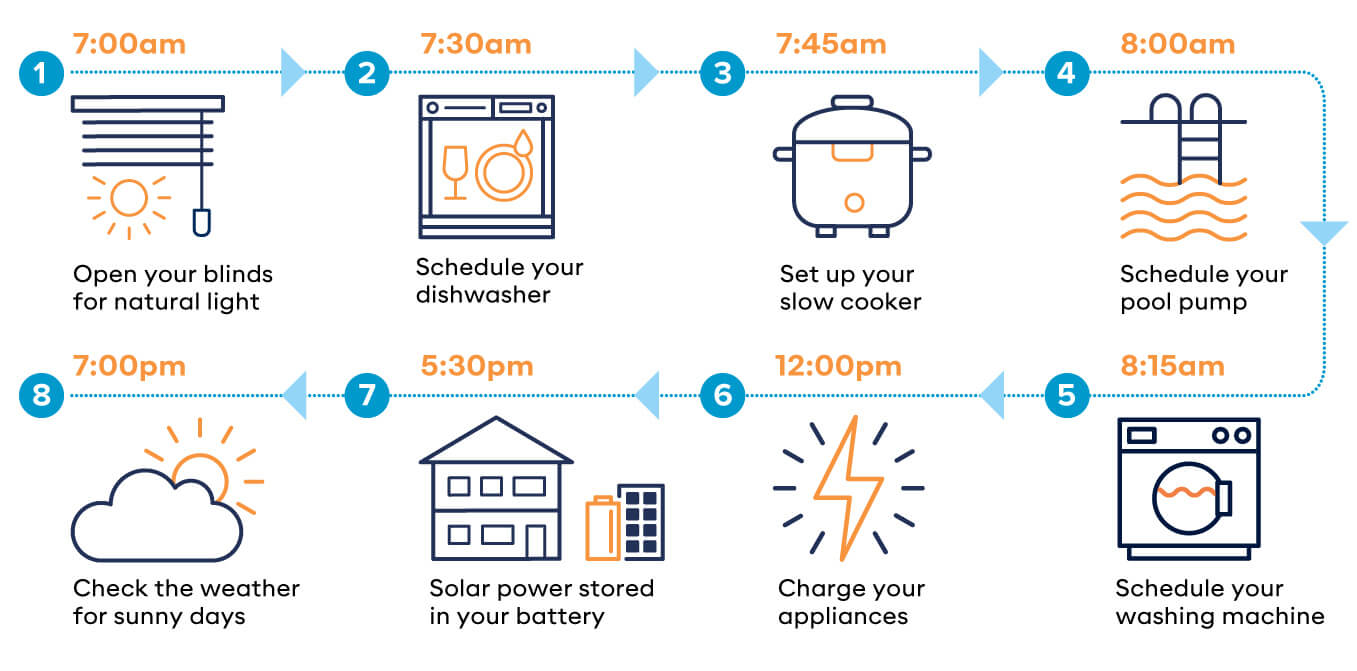A day in the life of a solar super-user
If you’re one of the many WA households tapping into the power of the sun through your solar panels, you might have seen some benefits in your electricity bills so far.
If you’re ready to take your solar savviness to the next level, there are some simple changes you can work into your daily habits and routines. These small changes can have a big impact on the way your household uses solar energy, which could translate into savings on your bill.
Here’s what a day in the life of a solar super-user might look like.
If you’re ready to take your solar savviness to the next level, there are some simple changes you can work into your daily habits and routines. These small changes can have a big impact on the way your household uses solar energy, which could translate into savings on your bill.
Here’s what a day in the life of a solar super-user might look like.

First, let the sunshine in
After caffeinating, meditating or hitting the snooze button seven times (no judgement here), you’re ready to take on the day. Throw the blinds open to let in that natural light and warmth when the sun starts shining. If it’s a hot day ahead, you’ll close these later to keep the hot sun out.
Plan ahead
The more solar energy you can use as it's being produced by your system, the better. To do this, look at how you can shift more of your electricity use to the daytime. This is known as load shifting. Planning ahead can help you make the most of your solar system.
Before you leave home or start work
A simple way to start load shifting is to look for a delay function on your appliances. For example, around 7.30am, you could load your dishwasher and set it to run with a three-hour delay. That means at 10.30am when your solar production is starting to peak for the day, your dishwasher will be running on that free solar energy.
As part of your morning routine, set up your favourite slow cooker recipe so dinner cooks while you’re working. This could help you save time later and you can make the most of your solar energy during the day.
As part of your morning routine, set up your favourite slow cooker recipe so dinner cooks while you’re working. This could help you save time later and you can make the most of your solar energy during the day.
Afternoon
Your heating, cooling, pool pump and other appliances might have apps or timers you can access to set them to work at the most efficient times. For example, running your pool pump on a timer at lunchtime means it is tapping into your solar energy, compared to first thing in the morning when you’re drawing electricity from the energy system, also known as the grid.
If you work from home, you might use your lunch break to charge up your phone, tablets or other appliances or run another load of washing.
You can add a smart meter to your solar system to see how much energy it’s producing. This can help you to know how much energy you have available.
If you work from home, you might use your lunch break to charge up your phone, tablets or other appliances or run another load of washing.
You can add a smart meter to your solar system to see how much energy it’s producing. This can help you to know how much energy you have available.
Evening
Once the sun has set, you’ll be drawing electricity from the energy system. If you have a solar battery, any excess solar power from during the day will be used now.
Look at the forecast for the week ahead and see how you can plan your chores around it. For example, a sunny day is better than a cloudy one when you’re changing your sheets. On a sunny day, you can make the most of your solar power to run your washing machine, then use the sunshine and fresh air to get those sheets dry.
You could also take the evening to review your solar data through your smart meter, if you have one. This will give you a clear picture of how you’ve used electricity throughout the day - and you can see where you’re a solar super-user and where you might be able to improve tomorrow.
Look at the forecast for the week ahead and see how you can plan your chores around it. For example, a sunny day is better than a cloudy one when you’re changing your sheets. On a sunny day, you can make the most of your solar power to run your washing machine, then use the sunshine and fresh air to get those sheets dry.
You could also take the evening to review your solar data through your smart meter, if you have one. This will give you a clear picture of how you’ve used electricity throughout the day - and you can see where you’re a solar super-user and where you might be able to improve tomorrow.
Learn more energy tips
We’re here to help you navigate WA’s changing energy landscape and help you discover the most affordable and energy-efficient solutions. The more you learn about the way you use energy at home, the more you can embrace your own energy future.
Small changes can make a big difference. For even more energy-saving ideas, try our Energy Tool.
Small changes can make a big difference. For even more energy-saving ideas, try our Energy Tool.
Share: